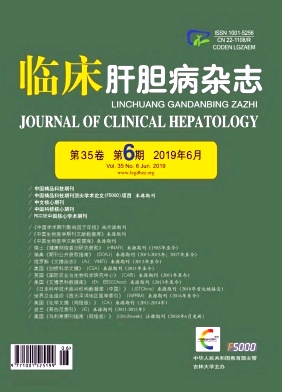|
[1]BRAY F, FERLAY J, SOERJOMATARAM I, et al.Global cancer statistics 2018:GLOBOCAN estimates of incidence and mortality worldwide for 36 cancers in 185 countries[J].CACancer J Clin, 2018, 68 (6) :394-424.
|
|
[2]WONG CM, TSANG FH, NG IO.Non-coding RNAs in hepatocellular carcinoma:Molecular functions and pathological implications[J].Nat Rev Gastroenterol Hepatol, 2018, 15 (3) :137-151.
|
|
[3]DHANASEKARAN R, LIMAYE A, CABRERA R.Hepatocellular carcinoma:Current trends in worldwide epidemiology, risk factors, diagnosis, and therapeutics[J].Hepat Med, 2012, 4:19-37.
|
|
[4]WARBURG O.The chemical constitution of respiration ferment[J].Science, 1928, 68 (1767) :437-443.
|
|
[5]LUNT S, VANDER HEIDEN M.Aerobic glycolysis:Meeting the metabolic requirements of cell proliferation[J].Annu Rev Cell Dev Biol, 2011, 27:441-464.
|
|
[6]LU J, TAN M, CAI Q.The Warburg effect in tumor progression:Mitochondrial oxidative metabolism as an anti-metastasis mechanism[J].Cancer Lett, 2015, 356 (2 Pt A) :156-164.
|
|
[7]FAN C, TANG Y, WANG J, et al.Role of long non-coding RNAs in glucose metabolism in cancer[J].Mol Cancer, 2017, 16 (1) :130.
|
|
[8]GANAPATHY-KANNIAPPAN S, GESCHWIND JF.Tumor glycolysis as a target for cancer therapy:Progress and prospects[J].Molecular cancer, 2013, 12:152.
|
|
[9]LI M, JIN R, WANG W, et al.STAT3 regulates glycolysis via targeting hexokinase 2 in hepatocellular carcinoma cells[J].Oncotarget, 2017, 8 (15) :24777-24784.
|
|
[10]DEWAAL D, NOGUEIRA V, TERRY AR, et al.Hexokinase-2depletion inhibits glycolysis and induces oxidative phosphorylation in hepatocellular carcinoma and sensitizes to metformin[J].Nat Commun, 2018, 9 (1) :446.
|
|
[11]CHESNEY J, CLARK J, KLARER A, et al.Fructose-2, 6-bisphosphate synthesis by 6-phosphofructo-2-kinase/fructose-2, 6-bisphosphatase 4 (PFKFB4) is required for the glycolytic response to hypoxia and tumor growth[J].Oncotarget, 2014, 5 (16) :6670-6686.
|
|
[12]SHI L, PAN H, LIU Z, et al.Roles of PFKFB3 in cancer[J].Signal Transduct Target Ther, 2017, 2:17044.
|
|
[13]SHI W, ZHU X, WANG C, et al.PFKFB3 blockade inhibits hepatocellular carcinoma growth by impairing DNA repair through AKT[J].Cel Death Dis, 2018, 9 (4) :428.
|
|
[14]SHU Y, LU Y, PANG X, et al.Phosphorylation of PPARgamma at Ser84 promotes glycolysis and cell proliferation in hepatocellular carcinoma by targeting PFKFB4[J].Oncotarget, 2016, 7 (47) :76984-76994.
|
|
[15]DAYTON T, JACKS T, van der HEIDEN M.PKM2, cancer metabolism, and the road ahead[J].EMBO Rep, 2016, 17 (12) :1721-1730.
|
|
[16]LUO W, SEMENZA G.Emerging roles of PKM2 in cell metabolism and cancer progression[J].Trends Endocrinol Metab, 2012, 23 (11) :560-566.
|
|
[17]WONG C, AU S, TSE A, et al.Switching of pyruvate kinase isoform L to M2 promotes metabolic reprogramming in hepatocarcinogenesis[J].PLo S One, 2014, 9 (12) :e115036.
|
|
[18]PENG Z, LIU C, WU M.New insights into long noncoding RNAs and their roles in glioma[J].Mol Cancer, 2018, 17 (1) :61.
|
|
[19]SUN M, KRAUS W.From discovery to function:The expanding roles of long noncoding RNAs in physiology and disease[J].Endocr Rev, 2015, 36 (1) :25-64.
|
|
[20]WANG K, CHANG H.Molecular mechanisms of long noncoding RNAs[J].Mol Cell, 2011, 43 (6) :904-914.
|
|
[21]WANG TH, YU CC, LIN YS, et al.Long noncoding RNA CPS1-IT1 suppresses the metastasis of hepatocellular carcinoma by regulating HIF-1αactivity and inhibiting epithelial-mesenchymal transition[J].Oncotarget, 2016, 7 (28) :43588-43603.
|
|
[22]HU JL, AN YL.The relationship between long non-coding RNA and hepatocellular carcinoma[J].Ogran Transplantation, 2017, 8 (3) :242-245. (in Chinese) 胡建兰, 安玉玲.长链非编码RNA与肝癌[J].器官移植, 2017, 8 (3) :242-245.
|
|
[23]LIN Y, WU M, HUANG Y, et al.Taurine up-regulated gene 1functions as a master regulator to coordinate glycolysis and metastasis in hepatocellular carcinoma[J].Hepatology, 2018, 67 (1) :188-203.
|
|
[24]LI Y, GUO D, ZHAO Y, et al.Long non-coding RNA SNHG5promotes human hepatocellular carcinoma progression by regulating miR-26a-5p/GSK3βsignal pathway[J].Cell Death Dis, 2018, 9 (9) :888.
|
|
[25]HUANG Y, XIANG B, LIU Y, et al.LncRNA CDKN2B-AS1promotes tumor growth and metastasis of human hepatocellular carcinoma by targeting let-7c-5p/NAP1L1 axis[J].Cancer Lett, 2018, 437:56-66.
|
|
[26]WANG Y, SUN L, WANG L, et al.Long non-coding RNADSCR8 acts as a molecular sponge for miR-485-5p to activate Wnt/β-catenin signal pathway in hepatocellular carcinoma[J].Cell Death Dis, 2018, 9 (9) :851.
|
|
[27]WANG H, KE J, GUO Q, et al.Long non-coding RNA CRNDEpromotes the proliferation, migration and invasion of hepatocellular carcinoma cells through miR-217/MAPK1 axis[J].J Cel Mol Med, 2018, 22 (12) :5862-5876.
|
|
[28]SUN Q, HU B, FU P, et al.Long non-coding RNA00607 as a tumor suppressor by modulating NF-κB p65/p53 signaling axis in hepatocellular carcinoma[J].Carcinogenesis, 2018, 39 (12) :1438-1446.
|
|
[29]ZHANG D, ZOU X, CAO C, et al.Identification and functional characterization of long non-coding RNA as a tumor suppressor for hepatocellular carcinoma[J].Theranostics, 2018, 8 (14) :3751-3765.
|
|
[30]TAKAHASHI K, YAN I, HAGA H, et al.Modulation of hypoxia-signaling pathways by extracellular linc-RoR[J].J Cell Sci, 2014, 127 (Pt 7) :1585-1594.
|
|
[31]YANG F, ZHANG H, MEI Y, et al.Reciprocal regulation of HIF-1αand lincRNA-p21 modulates the Warburg effect[J].Mol Cell, 2014, 53 (1) :88-100.
|
|
[32]XIANG S, GU H, JIN L, et al.LncRNA IDH1-AS1 links the functions of c-Myc and HIF1αvia IDH1 to regulate the Warburg effect[J].Proc Natl Acad Sci USA, 2018, 115 (7) :e1465-e1474.
|
|
[33]ZHENG X, HAN H, LIU GP, et al.LncRNA wires up Hippo and Hedgehog signaling to reprogramme glucose metabolism[J].EMBO J, 2017, 36 (22) :3325-3335.
|
|
[34]LI S, LI J, DAI W, et al.Genistein suppresses aerobic glycolysis and induces hepatocellular carcinoma cell death[J].Br JCancer, 2017, 117 (10) :1518-1528.
|
|
[35]LI S, DAI W, MO W, et al.By inhibiting PFKFB3, aspirin overcomes sorafenib resistance in hepatocellular carcinoma[J].Int J Cancer, 2017, 141 (12) :2571-2584.
|









 本站查看
本站查看




 DownLoad:
DownLoad: